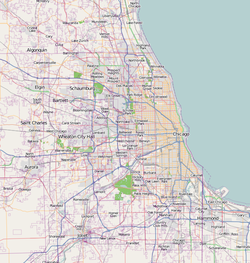
The William H. Roberts House is a late 19th-century house located in Pecatonica, Illinois, United States. The house was built in 1883 for Dr. William H. Roberts, who died three years later at the age of 33. The building features a combination of elements from three distinct architectural styles, Italianate, Queen Anne and Gothic revival. The building functioned as both Roberts's house and office. The house is the only building in Pecatonica listed on the United States National Register of Historic Places, a status it attained in 1979.

The Lake–Peterson House, also known as Jenny's, is a Victorian Gothic Revival home in Rockford, Illinois, United States. The house was built in 1873, probably by prominent Rockford citizen John Lake - its first owner, but its architect is unknown. The house is a significant example of Gothic Revival architecture and is considered one of the finest such homes in the U.S. state of Illinois. The Lake–Peterson House is owned and maintained by Swedish American Hospital in Rockford and stands adjacent to the main hospital complex along Business US 20. The building and its carriage house were added to the U.S. National Register of Historic Places in 1980.

The Plano Stone Church was constructed in 1868 to serve as the headquarters for the Reorganized Church of Jesus Christ of Latter Day Saints under the leadership of Joseph Smith III. Smith moved to Plano, Illinois, in 1866 and in 1867 was appointed head of the Stone Church's building committee. Smith and the committee selected the site, design and builder for the structure. The Plano Stone Church served as the headquarters of the RLDS from its completion in 1868 until Smith, his family, and the church moved to Lamoni, Iowa, in 1881.

Ambler's Texaco Gas Station, also known as Becker's Marathon Gas Station, is a historic filling station located at the intersection of Old U.S. Route 66 and Illinois Route 17 in the village of Dwight, Illinois, United States. The station has been identified as the longest operating gas station along Route 66; it dispensed fuel for 66 continuous years until 1999. The station is a good example of a domestic style gas station and derives its most common names from ownership stints by two different men. North of the station is an extant outbuilding that once operated as a commercial icehouse. Ambler's was the subject of major restoration work from 2005–2007, and reopened as a Route 66 visitor's center in May 2007. It was added to the U.S. National Register of Historic Places in 2001.

Central House is an 1860s hotel building located in the 800-person village of Orangeville, in Stephenson County, Illinois, United States. The building was built by Orangeville founder John Bower and operated as a hotel from its construction until the 1930s, when it was converted for use as a single family residence. The three-story building was the first commercial brick structure in downtown Orangeville. Architecturally, the building is cast in a mid-19th-century Italianate style. Central House was added to the U.S. National Register of Historic Places in 1999.
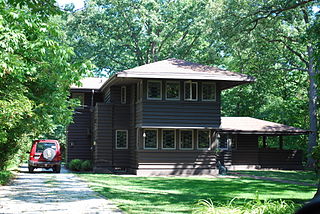
The George Madison Millard House, is a Frank Lloyd Wright designed Prairie School home that was constructed in Highland Park, Illinois, United States in 1906. It was the first of two houses that Wright would design for the Millards.

The Masonic Temple Building is a historic Prairie-style building in Oak Park, Illinois, at the corner of Oak Park Avenue and Lake Street. It is in the Ridgeland-Oak Park Historic District and was individually listed on the National Register of Historic Places in 1982.
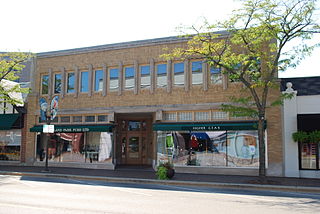
The Humer Building is a historic commercial building at 1894 Sheridan Road in Highland Park, Illinois. Built in 1926, the building houses two retail spaces on its first floor and office space on its second floor. Architect John S. Van Bergen, a former employee of Frank Lloyd Wright, designed the Prairie School building. While Van Bergen designed many homes in the same style, it was not commonly used in commercial buildings, and the Humer Building's design is unique among commercial buildings in Chicago's northern suburbs. The building features ribbon windows, geometric designs on the inside, and patterned glass on its staircase, all typical Prairie School elements.
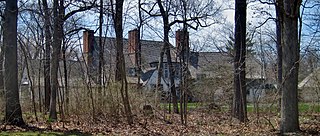
The Harold Florsheim House is a historic house at 650 Sheridan Road in Highland Park, Illinois. The house was built in 1925-28 for businessman Harold M. Florsheim, who later became the president of Florsheim Shoes. Chicago architect Ernest Grunsfeld, who went on to design the Adler Planetarium, designed the house in the French Chateau style. The house includes a gable above the entrance, a multi-story three-sided bay window, casement windows, and a hip roof broken by dormers. Landscape architect Jens Jensen designed the house's grounds, making use of a ravine on the property to instill a sense of privacy.
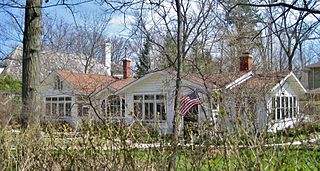
The Albert Campbell House was a historic house at 434 Marshman Avenue in Highland Park, Illinois. The house's construction date and builder are unknown, though it was most likely built in the early twentieth century. The house has a bungalow-style design inspired by the American Craftsman movement. The house's design features a low profile and several stained glass and etched glass windows. A sizable addition was placed on the west side of the house in 1927, and a second addition was added in the 1930s.

The Granville-Mott House is a historic house at 80 Laurel Avenue in Highland Park, Illinois. Built circa 1910, the house was designed by prominent Chicago architectural firm Tallmadge & Watson. The firm designed two houses and a church's chancel in Highland Park; the Granville-Mott House is the largest of these works. The house has a Tudor Revival design with Prairie School details. Its gable roof and extensive half-timbering are typical Tudor elements, while its casement windows and overhanging eaves are inspired by the Prairie School.
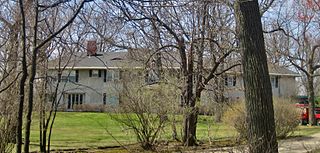
The Richard Churchill House is a historic house at 1214 Green Bay Road in Highland Park, Illinois. The house was built in 1908 for the Churchill family, which used the last name Kirschberger at the time but later changed it due to anti-German sentiment during World War I. Architect Alfred S. Alschuler, who was also known for his work on skyscrapers and industrial buildings in Chicago, designed the house. The house has an English country house design, a popular choice for early twentieth-century suburbanites building on large plots. The two-story house has a stucco exterior, an entrance flanked by columns and latticework, and a Palladian window above the entrance.

The C. S. Soule House is a historic house at 304 Laurel Avenue in Highland Park, Illinois. The house's builder and construction date are uncertain, but it was most likely built circa 1880. Its first documented resident was C. S. Soule, the pastor at the Highland Park Presbyterian Church and a professor at the Highland Hall women's school; Soule lived in the house from 1880 to 1886. The house has a Gothic Revival design with several front-facing gables, a three-bay window, and an open porch. The property originally had a barn behind the house; this was demolished in 1978, and an attached two-car garage was added the following year.
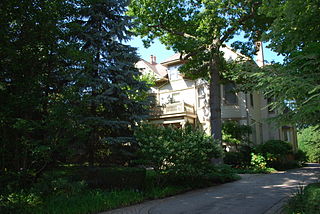
The Ross Beatty House is a historic house at 1499 Sheridan Road in Highland Park, Illinois. Built in 1893, the house is the first of two homes built for steel magnate Ross J. Beatty in Highland Park. The house was primarily designed in the Queen Anne style, but it also incorporates elements of Classical Revival architecture. The house's Queen Anne influence is mainly present in its massing and complex roof structure with multiple dormers. Its Classical Revival influence can be seen in its decorative elements, including many pedimented windows and sidelights flanking the entrance.
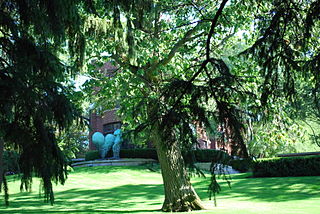
The Ross J. Beatty House, also known as Halcyon Hall, is a historic house at 344 Ravine Drive in Highland Park, Illinois. Built circa 1909, the house was the second of two homes built in Highland Park for steel magnate Ross J. Beatty. Originally situated on a large lot, the house is a Tudor Revival-style mansion with a carriage house, greenhouse, and gazebo on its grounds. Its lot was later subdivided, and multiple other houses now stand on its former grounds. The house's design includes a brick exterior, bas-relief stone carvings, decorative half-timbering, and a complex roof with several dormers and chimneys.

The George Pick House is a historic house at 970 Sheridan Road in Highland Park, Illinois. The house was built in the early twentieth century for businessman George Pick. Prolific Chicago architect Howard Van Doren Shaw, who also designed several other homes in Highland Park, designed the house. Shaw gave the house an Eclectic Revival design with extensive detail work inspired by architectural styles from throughout Europe. The house's features include carved limestone birds, gables with decorative bargeboards, and an arcade at the entrance.

The Mrs. Frank Geyso Houses are two neighboring houses at 450 and 456 Woodland Road in Highland Park, Illinois. The earlier house at 450 Woodland was built in 1923–25, while the later house was built in 1930. John S. Van Bergen, a prominent Chicago architect who designed several other homes in Highland Park, designed both houses in the Prairie School style. The house at 450 Woodland is a cottage-style building with a stucco exterior and wood detail work. The house at 456 Woodland is a brick building with an entrance pavilion, a balcony, and overhanging eaves.

The Samuel Holmes House is a historic house at 2693 Sheridan Road in Highland Park, Illinois. Built in 1926, the Shingle style house was designed by architect Robert Seyfarth. The house is one of several Seyfarth-designed buildings in Highland Park and a rare example of the Shingle style in the city. The house's design includes an asymmetrical form, a gable roof with inset dormers, and a cedar shake sided exterior. Noted landscape architect Jens Jensen designed the house's grounds.

The Lichtstern House is a historic house at 105 S. Deere Park Drive in Highland Park, Illinois. The house was built in 1919 for a businessman named E. Lichtstern. Arthur Heun, a Chicago architect known for designing homes for the upper class, designed the house. Heun's design primarily used Italian Villa architecture, which was inspired by Lichtstern's travels to Italy, but also includes some Prairie School elements. Its overall form, use of segmental arches, and balconies are typical of the Italian Villa style, but its leaded glass windows and overhanging eaves are Prairie School features.
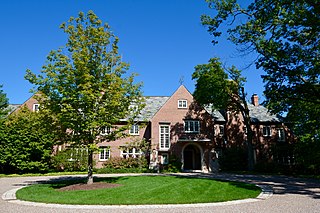
The A. G. Becker Property is a historic estate at 405 Sheridan Road in Highland Park, Illinois. The estate was built in 1921 for businessman A. G. Becker. Architect Howard Van Doren Shaw designed the estate's brick Tudor Revival house, which has been modified significantly since its construction. Landscape architect Jens Jensen designed the estate's grounds, which include typical elements of Jensen's such as native plants and decorative rockwork. The grounds also include one of the few surviving Jensen-designed meadows, a once-common feature of his work that was often lost to land divisions and development.
